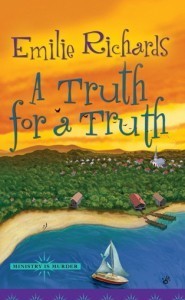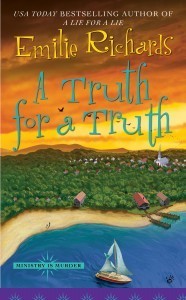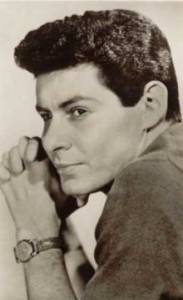Emilie Richards's Blog, page 144
October 3, 2010
The Challenging Life of a Minister's Wife, Part Two–An Interview With Emilie Richards
 I'll confess that when I recently interviewed Aggie Sloan-Wilcox for this blog, she was only too happy to comply. However there was a caveat. Aggie claimed that to be fair, I ought to submit to an interview with her, as well. Aggie's nothing if not determined. And those of you acquainted with her know that Aggie always gets her man or woman. Sometimes a little late, but hey, nobody's perfect.
I'll confess that when I recently interviewed Aggie Sloan-Wilcox for this blog, she was only too happy to comply. However there was a caveat. Aggie claimed that to be fair, I ought to submit to an interview with her, as well. Aggie's nothing if not determined. And those of you acquainted with her know that Aggie always gets her man or woman. Sometimes a little late, but hey, nobody's perfect.
I explained to Aggie that I really had very little to say about my life. After all, I am a minister's wife, just like she is, and what could possibly happen that's worth recording here? She just looked at me, then I remembered to whom I was speaking. Okay, that excuse fell flat.
So, in the interest of justice–a biggie with our Aggie–I've decided to comply. Aggie promises to keep this short. And after all, lately Truth is an issue with my favorite clerical sleuth. We'll hold her to it.
Emilie, I wonder if writing a mystery series about a church and congregants who kill or get killed was all that wise a step, particularly since your own husband is still a minister? Has that decision ever come back to haunt you?
I've purposely set my series in a very different environment from the church my husband and I are part of. While the Consolidated Community Church of Emerald Springs is a liberal church, it draws from several denominations for its clerical leadership. The church is small and fairly traditional in some of its practices. The town of Emerald Springs is small, as well, and midwestern, with its own unique flavor. I live in Northern Virginia, just a stone's throw from Washington DC. When the president throws a party complete with fireworks, we hear them–and wonder if we're under attack. Politics is our life blood and politicians adorn our hallways. Our church is solidly Unitarian-Universalist and very large. At any given moment there are at least half a dozen events taking place within its walls, often related to social justice. So while there are some similarities, there are many more differences.
Surely, then, your portrayal of Ed, my husband, must be based on the real life personna of yours?
I have been extraordinarily careful to be sure that Ed and my husband are sufficiently different that nobody would confuse them. Ed is first and foremost a scholar. A small church with a large endowment is perfect for Ed, who hopes to have extra time while in Emerald Springs to pursue academic research. My husband enjoys scholarly research, but he enjoys all the others facets of his job as much, particularly the people contact. Their common ground? A respect for their job and enthusiasm for doing it.
So you're saying that nothing in your background led you to write about a small town in Ohio?
Aggie, Aggie, did I say that? Exactly? There was a church, a small church in a small town. Not in Ohio but close. Very, very close. (You know who you are.) Seriously, although no one and no event in the books is related to any church we have ever been part of (note the disclaimer) the town of Emerald Springs is just the teensiest similar to Meadville, Pennsylvania, where we lived for six of the best years of our lives. I've been back to the church to sign the Ministry is Murder series, and they were delighted.
I'm always surprised to see the covers of "my" books. Do you have any say on what's there?
I do have some input. For A Truth For A Truth, I asked for a darker, less "friendly" cover, and my publisher complied. The new version was quite wonderful, but somewhere between their revision and publication, the old version went to print instead. So if the book does well and the first printing is sold out, you'll see the cover to the right on the stands eventually. Note the differences.
One thing that must be true. You spend a lot of time developing my family life. Do you have children of your own? Were any of them like Deena and Teddy?
I have four children, and in no way do any of them resemble yours. But they are, in their own ways, exceptional and charming–and for the most part, male.
Finally, have you ever lived in a parsonage? You seem to know the problems well.
My only experience with parsonages came during my husband's two sabbaticals in Australia. The church he served came with one, a beautiful, very special space that is probably one of the most charming houses we ever lived in. I will think of it fondly forever. But I only lived there a few months each time. Even then, it was "life in a fishbowl." So your experiences, Aggie, come from my own, and the stories other ministers and minister's partners have passed on to me. Just so you know, you have my sympathy. But that floor? The one that needs waxing continuously? I'm afraid that is based on real life. I wonder if it's still there.
Look for Aggie and Emilie Richards at your favorite bookstore. A Truth For A Truth will be on mystery bookshelves this week. Enjoy.
September 30, 2010
Sniffing Out A Story, One Piece of Evidence At A Time
I'm still not quite sure how this happened. One moment I volunteered to dog-sit for the pathetic puppy that my son and daughter-in-law had rescued from the path of a bush hog and nursed back to health. The next I was on the telephone with my husband, who was out of town at a conference. "Remember that beagle puppy the kids are trying to find a home for? Well, they found one."
Then, mimicking the words of generations of small children before me, I added: "Of course since this was my decision, I'll do all the work." And I meant it. . . exactly the way all those little kids had.
Today Nemo, the rascally beagle puppy, is an adult lap dog. While the puppy Nemo never met a creature he didn't like, the adult Nemo is much more reserved. Show him a deer and he looks the other way. He terrorizes sticks and rocks exclusively, leading us to view more x-rays of a beagle stomach than we ever hoped to see. While he has his private pack, my husband and me, the son and daughter-in-law who rescued him and their dogs, most of the rest of the world is excluded, unless they come with treats in hand. I spent more money this past week discussing Nemo's peculiarities with my vet than I would have spent at a psychiatrist.
Today on our walk, after I pulled him past a monster trash Dumpster, through sprinkles of acid rain, across Beagle-Bashing-Boulevard (two lanes, no traffic) we finally got to the woods (most likely the same woods where Little Red Riding Hood met the wolf). At the border Nemo dove under the thickest canopy of trees, plunked himself down and stared at me as if to say: "You go ahead, I'll be here waiting." Although my arms are now as sturdy as tree trunks from hours of beagle pulls, I gave in and home we went. Along the way we passed the world's smallest and cutest cocker spaniel. Nemo, of course, gazed at the horizon, and the friendly little interloper went its merry way.
And that's when Nemo showed his true colors. While completely uninterested in socializing with this potential new friend–a harmless friend twenty pounds lighter and inches shorter–Nemo was now utterly fascinated. He sniffed every inch of the dog's path to that point, until he knew all there was to know.
Voila! I finally understand. Nemo has the heart of a novelist. No wonder I fell in love with him. Nemo, like those of who write, is most comfortable tracing the paths of others, finding out where they've been, maybe even wondering where they might next go, than he is in actual encounters them. He is a detective, happiest ferreting out the intricate details, the secrets, and yes, the evidence left behind.
Even before that revelation, I wouldn't have traded a scrap of fur from Nemo's blue tick body for a less neurotic dog, but now maybe I can relate to him a bit better. The next time he puts nose to the ground to follow a scent no human could ever detect, I will understand. Nemo's looking for a story. If only he could talk.
September 26, 2010
"I Was Adorable"–Eddie Fisher and The Men We Love
 Eddie Fisher died this week, and now, thanks to this morning's excellent Washington Post obituary, the man and his "impact" are on my mind. I'm a novelist, after all, and understanding the human heart is my job, maybe even my responsibility.
Eddie Fisher died this week, and now, thanks to this morning's excellent Washington Post obituary, the man and his "impact" are on my mind. I'm a novelist, after all, and understanding the human heart is my job, maybe even my responsibility.
I'm just old enough to remember Eddie Fisher as someone other than the father of Carrie, the volatile, multi-talented Princess Leia of Star Wars fame. My mother, who followed the lives of celebrities with the fervor we in the DC area usually save for politicians, was devastated when Eddie divorced Debbie Reynolds in favor of Liz Taylor. Forever after, in my mother's heart, Liz was the trashy other woman, and Debbie, the courageous champion of all women who had been trampled by their men. Mom was, unfortunately, in need of a heroine with those qualifications.
Like children all over the world, I rejected the idols of my parents. I was perplexed at the attention paid to the skinny, jug-eared crooners of their generation. I found the voices and personalities insipid, the antics perplexing. I understood perfectly why girls screamed when Paul McCartney and the Beatles stepped onstage. But Frank Sinatra? Okay, those blue eyes were mesmerizing, and there was a certain scrappy, street kid bravado that translated well to film. Eddie Fisher? Sexy? The man's most popular song was "Oh My Papa." What did this say about an entire generation?
Married five times, three times to well-known celebrities (Connie Stevens was the third), his 1999 memoir recounted a life of drug abuse and affairs. He claimed he spent $20 million on drugs and gambling in his lifetime. He was never quite certain why he couldn't regain his popularity, but after divorcing both Debbie and Liz, he spent his remaining years playing second-rate venues and documenting affair after affair. When the memoir aired, Carrie Fisher wrote: "That's it. I'm having my DNA fumigated." Having had moments like that myself, I can relate.
I'm always perplexed at the men with whom we as a culture fall in and out of love. I think I understand the rise and fall of Eddie Fisher. He was loved for his sweet, boyish charm. About himself he said: "I wasn't the handsomest of men, but I was adorable." He was safe to love, user-friendly as it were. So, as a matter of fact, were the Beatles–at least at the beginning. But while in later years the Beatles toughened their image and matured into interesting if not perfect men, Eddie's failures, first as a husband and father, then as the lover who was quickly cast aside by the glamorous Liz, were so well documented he could never surge beyond them. He not only didn't give his public what they wanted, he wasn't even a success at the things they didn't want. Had he been, had his marriage to Liz succeeded until he ended it, I think he would have been forgiven for leaving his first family. His star might well have continued to shine.
As a culture, nothing impresses us like success. Imagine me telling my editor I want to write a novel about a nice man, kind to animals and little kids who plays the harmonica with a sweetness that brings tears to our eyes. Still, this sweet, lovable guy loses at everything he attempts, and at the end he loses his way into the sunset. What do you think? Interested? On your way to the book store to pre-order?
Eddie Fisher may well have been, by the standards of his generation, "adorable." He may even have been a guy we'd enjoy having over for Sunday night dinner and a sing-along. But he fell flat on his face in public and never picked himself up. At the end of his much ballyhooed second marriage, Liz Taylor called him "the busboy." We, the people, are interested in the guy dining at the head table. These days we're even interested in the celebrity chef in the kitchen. But we are never, never interested in the busboy, unless he's clearing tables on his way to stardom.
Our society has an enormous capacity for forgiveness. We love our reformed scoundrels, even when that reform is only for show. But give us a winner every time. I'm not sure what this says about us. Perhaps that we're easily fooled? Unable to distinguish between what's important and what's not? Or maybe it says that in a world that's tough for everybody, those celebrities who seem to succeed give us hope that we, foibles and all, can do the same.
September 23, 2010
The Book That Will Not End–When One Novel Becomes A Series
 Two weeks ago I asked my Facebook "fans" to suggest topics they'd like me to blog about here. Then I sweetened the pot by doing a giveaway in conjunction. Three commenters were chosen at random and received autographed copies of my novels. See what you miss if you're not hanging out with us on the page? We're a wild and crazy bunch.
Two weeks ago I asked my Facebook "fans" to suggest topics they'd like me to blog about here. Then I sweetened the pot by doing a giveaway in conjunction. Three commenters were chosen at random and received autographed copies of my novels. See what you miss if you're not hanging out with us on the page? We're a wild and crazy bunch.
Now the winners have their books and I have twenty-nine good suggestions. While I probably don't have enough to say about every subject submitted, some of them leaped right out at me. Today's idea was proposed by Audrey Bonnell, who asked: "How do you know when a book you write is going to be a series? Do the people just keep shouting in your head wanting to get out? Or is there just too much about each one to make it into just one book?"
This suggestion comes at such a good time. Last night I finished the rough draft of Sunset Bridge, the third and final Happiness Key novel. Usually at the end of a rough draft I'm writing so fast and furiously I'm shocked when I finish, taken by surprise and instantly deflated. This time, not so much. Because Sunset Bridge was the final book of three, I had a slew of plot threads to tie up in that final chapter. What I'd expected to be a brief epilogue turned into a twenty page extravaganza. I truly began to think this was the book that would never end. At 9:30PM it finally did, although I'm already making lists of the things I must rewrite and change before I even begin my normal edits.
The Happiness Key series was unusual for reasons I'll explain in a moment. I've done a lot of interconnected books, beginning back in (gulp) 1985, with a traditional romance titled Sweet Georgia Gal, which was recently made into a film for German TV. (You can read more about that here.) Sweet Georgia Gal introduced a young woman who was the oldest girl in a large family. That background was important for her character development, but after I finished the novel, I realized there were four other sisters hanging around Gainesville, GA, waiting for their own novels. Eventually each of them got one.
The "Sweet" series hooked me. If I was going to spend that much time developing characters and intricate plots, why not explore them a bit more and use what I knew in connected novels? So began a history of doing just that, as well as a history of NOT planning ahead. The exception was a series for Silhouette Intimate Moments that we called the Tales of the Pacific series. I'm delighted to add that it looks like every one of those Tales novels will also be made into a TV movie in Germany, and three have already aired. In fact, if your German is up to speed, you can view the third (actually the first of my series) right here: Zeit de Vergebung. It premiered on Sunday and will be available on the Internet for about a week.
When I began writing longer women's fiction novels, I followed the same path. I blogged recently about the way one book became two: Iron Lace and Rising Tides, when the original manuscript was too long to publish. That was unusual. More often I wrote a novel, then, when readers asked for an update, I happily gave them one. I guess I'm easy.
The Shenandoah Album series grew the same way, one book, then another. As most of you know, we stopped after five, a publisher decision. I am still hoping to write that sixth and final novel. Stay tuned.
I told you that Happiness Key was different. As it turns out, not different in the way it grew. It, too, was intended to be a single title. Once it was finished, though, my publisher liked it so well, they asked for "more like this." Considering I had four major characters whose lives still weren't smooth sailing, I offered two more novels to create a trilogy, an offer that was happily snapped up. Fortunate Harbor, book two, came out this past July, and the aforementioned Sunset Bridge, will be published next summer.
So in what way is the Happiness Key series different? And why did Sunset Bridge become the book that would not end? Happiness Key is a friendship novel, and the relationship among the characters WAS the plot. So when the time came to move forward and do two more, I moved forward with all the same characters, all of whom had plots of their own that moved forward, too. The Donaghue sisters stories were similar (Whiskey Island and The Parting Glass) but Happiness Key had a twist. There was a "fifth" house in their beachfront community, and the characters who moved in and out of it were also important to each novel. This meant I had a "cast of thousands" to work with at a time when publishers are demanding shorter novels.
Yikes! So what have I learned? Well, it's possible to stay sane and produce stories I'm proud of under these conditions. I know that anyone who enjoyed the first two Happiness Key novels will be happy with Sunset Bridge, as well. And I think anyone picking it up, without reading the others, will also be happy they did. Even with all those characters who need final conclusion to their personal stories, the book still moves quickly. And the "new" character, who comes to live in the fifth house, was great fun to introduce. I'm proud of this novel, and proud of the series. But what else did I learn?
Here comes the big revelation. As much fun as it is to take a single title idea and turn it into a series, this is probably not the easiest way to begin one. Clearly I love to write connected books, and sixty something later, I ought to remember that before I begin. The upshot? For the next series I plan to propose, there will be interconnected characters, but every one of them will NOT need his or her own story in each and every novel.
Want to know more about that? Well, stay tuned, so do I. I love this new idea so much. We'll see if my publisher agrees. Fingers crossed.




